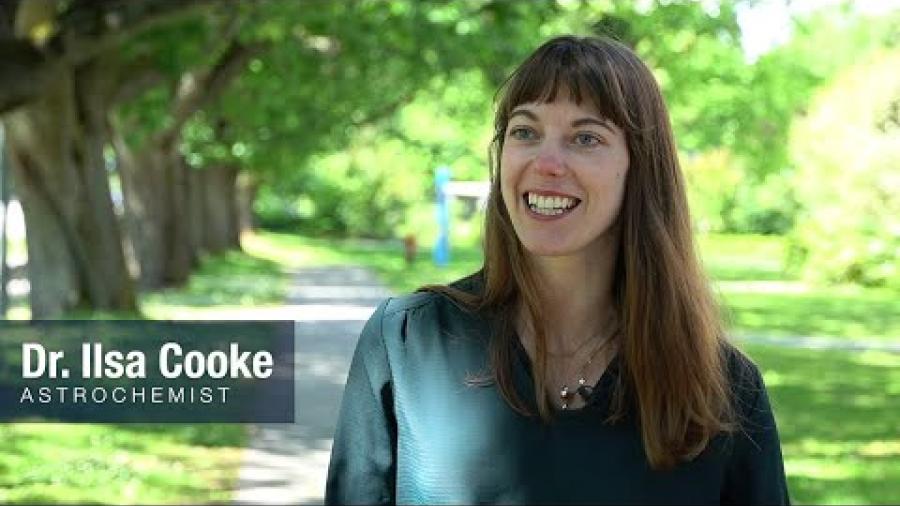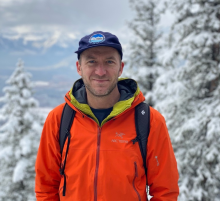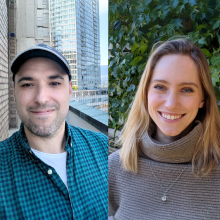
The truth is out there. That tag line from The X-Files, large segments of which were filmed in UBC Chemistry’s D Block, nicely sums up the research of UBC astrochemist Dr. Ilsa Cooke.
The stately, ivy covered D Block is a fitting place for Dr. Cooke to begin her independent research career as she settles in to her first semester at UBC Chemistry. Dr. Cooke is setting up a lab that will replicate the unforgiving conditions of deep space—a vacuum where temperatures hover around minus 260° Celsius. Dr. Cooke studies how molecules form hundreds of light years away in the gigantic clouds of dust and ice that are the birthplace of stars.
“There is nitrogen, carbon and hydrogen in space, all of the atoms that we have in organic molecules on Earth,” Dr. Cooke says. “The question is, if molecules can combine in space, can they make the amino acids that combine to create DNA and RNA, the building blocks of life? Because if they're in space, they could be on other planets, too.”
In the early 1900s, it was thought that full molecules could not exist in space because of the harsh UV radiation. That theory changed in the 1960s when astrochemistry took off following the advancement of radio telescopes during the Second World War. Radio astronomy has been used to detect almost 250 molecules in space—each has a unique electromagnetic signal depending on its mass and the bonds within the molecule.
“It's like a fingerprint,” Dr. Cooke says. “If you have a specific radio or microwave signal coming from a molecule, we can tell which one it is.”
Do something that you enjoy
Unlike many children who are fascinated by space, science wasn’t Dr. Cooke’s favourite topic at school. She loved all her classes growing up on New Zealand’s South Island with her twin brother, the children of a young single mother.
“I know how difficult it was with two young kids. Mom didn’t have a lot of money,” Dr. Cooke recalls. “She didn't finish high school and wasn’t very interested in academics. She worked a lot of jobs here and there. My favorite one was when she worked in a donut factory and she used to bring donuts home for us—that was great.”
“Part of the reason I really liked school was because it was a way to move away from a low socioeconomic background. I worked through high school at the general store in the tiny town I grew up in. That experience made me want to go to university. I couldn’t see myself flipping burgers the rest of my life. I wanted to do something that I really enjoyed doing every day.”
Dr. Cooke was especially good at science, even though she found it the most challenging. Despite financial hurdles, she decided to apply to university to continue in science.
At the University of Otago she studied chemistry, physics and mathematics, working every summer doing research on chemistry. When it was time to think about a PhD, Dr. Cooke realized she’d have to leave New Zealand because no researchers there were conducting space chemistry except for the group that she was already in.
She travelled to the U.S. in search of astrochemistry groups. Fortunately, Cooke received a Fulbright Fellowship which made getting into graduate school in the U.S. a lot easier. She chose the University of Virginia in Charlottesville, appreciating its small town feel.
The death of her PhD advisor part way through graduate school devastated Dr. Cooke and made her consider leaving the program and threatened the progress she had made.
“In some ways it prepared me well for this position at UBC because even at the PhD stage I was managing the lab myself. I had to figure out how the equipment ran. If the machines broke, I’d be the one to fix them, because there was no one else around. That was probably the toughest time of my career.”
Fortunately, Harvard professor Karin Öberg became her unofficial supervisor from afar. She proved to be a valuable mentor, coaxing Dr. Cooke out of the lab to network at a conference in Chile. Dr. Cooke submitted an abstract and was invited to give a talk at the conference where Öberg made introductions that led to a postdoctoral position for the young astrochemist.
Chemistry is changing
As you walk along the main hallway of the Chemistry Department’s aging D block, hair and clothing styles evolve in the faculty group photos. The 1920s black and white prints give way to faded Kodachrome shots, then the vibrant hues of 21st century pictures. And as you progress, women appear, rarely at first but with growing frequency as the decades pass.
“Chemistry is changing very quickly and there are many more women in the field,” Dr. Cooke says. “But it’s still challenging for women in day-to-day settings where other people might not recognize the problems that women are facing. I think young women entering the field will, at least for some time, still be faced with those challenges.”
Dr. Cooke’s research at UBC will focus on how ice sits on dust grains and how gas reacts at very cold temperatures. The work builds on her postdoctoral studies at the University of Rennes in France, where she worked with a group studying the huge technical challenge of making very cold gas without forming ice and then measuring the molecules within it. To conduct their experiments the group designed and built large vacuum chambers that were pumped by four gigantic vacuum pumps each the size of a small car.
“It was a small group, maybe 20 or so people who worked very closely together,” says Dr. Cooke. “There were long lunch breaks where we would sit for maybe two hours chatting. It was close knit environment, a collaborative group where they were senior people, postdocs and students, but there wasn't much of a hierarchical structure. Actually, I think now that I have to be the boss, I kind of miss that.”
In addition to running her UBC lab and taking on two PhD students, Dr. Cooke will teach first year General Chemistry (CHEM 123) in January 2023.
“I’ve never taught that many students at once so I'm sure that'll be another challenge,” she says. “I'm really excited about it. I like the idea of seeing people get really interested in chemistry.”
Related Links:
Dr. Ilsa Cooke's faculty profile at UBC Chemistry
Dr. Ilsa Cooke's research website


